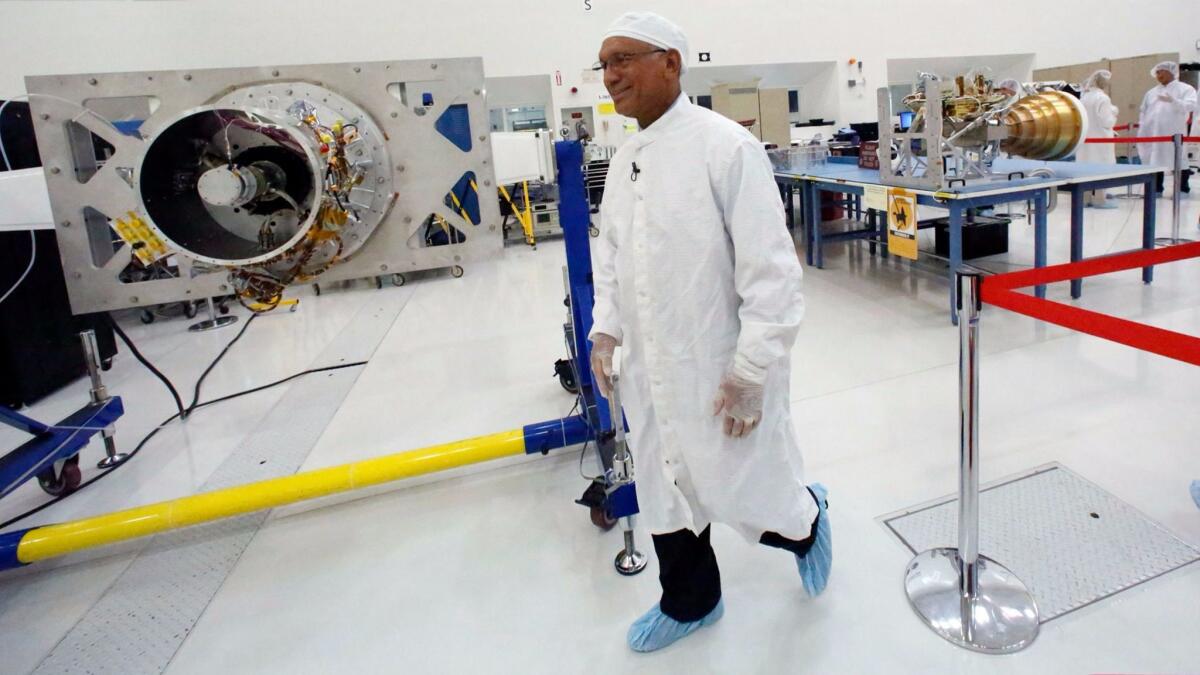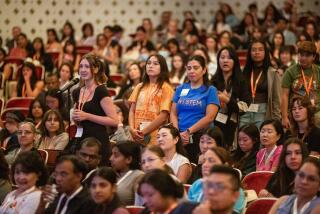‘Hidden Figures’ may feature NASA’s history, but it resonates in the present

- Share via
When NASA mathematician Katherine Johnson asks to join a high-level briefing in the run-up to astronaut John Glenn’s historic 1962 flight in the film “Hidden Figures,” an engineer rushes to shut the idea down.
“There’s no protocol for women attending,” he replies — an excuse that Johnson quickly bats aside.
“There’s no protocol for a man circling the Earth either, sir,” she says.
That conversation sketches the two-front battle fought by NASA’s black female mathematicians and engineers as they worked toward a Cold War victory: beating the Soviet Union at the space race and overcoming the many layers of prejudice in the Jim Crow South.
“Hidden Figures,” which entered wide release Friday, tells the story of Johnson, Dorothy Vaughan and Mary Jackson — three “computers,” women who were hired to do calculations from the engineers’ experiments but were not given the titles of mathematician or engineer.
Together with an eponymous book by Margot Lee Shetterly, the film about these three real-life women (played by Taraji P. Henson, Octavia Spencer and Janelle Monae, respectively) reveals a long-overlooked chapter in a story often depicted as overwhelmingly white and male.
NASA Administrator Charles Bolden, the first African American to head the agency, said he encouraged his employees to go see it.
“I say they will laugh their little backsides off, they will cry a lot, they’ll get very, very angry — and they’ll come out of it feeling incredibly proud that they’re a member of the NASA family,” he said.
In the movie, the women carefully navigate a minefield of moments shaded with varying degrees of prejudice; they’re made to use bathrooms for nonwhites and, in Johnson’s case, assumed to be a maid. To Bolden, many of those moments felt very familiar.
“I think we’ve all experienced things like that,” said Bolden, who grew up in segregated Columbia, S.C. And it’s still an issue today, he said. “If I’m in my jeans and T-shirt and I walk into somewhere where nobody knows I’m the NASA administrator, even around Washington, D.C., there are some places I can go where the worst is assumed.”
In the NASA of the ’60s, computers were given lower pay than their colleagues, few opportunities to advance and often weren’t given credit for their work. While it was a foot in the door for many talented black (and white) women, it also was a job that largely prevented them from publishing papers under their own names or giving talks — which typically factored heavily into promotions, said Christine Darden, a retired NASA aeronautical engineer featured near the end of the book.
Darden, the first black woman promoted to senior executive service at NASA’s Langley Research Center in Virginia, went to school with one of Johnson’s daughters and joined Langley as a computer a few years after the film’s events. She eventually asked a higher-up why she and other women ended up in dead-end jobs.
“When I asked him that question, he said, ‘Well, nobody complained about that before,’ ” said Darden, who then was transferred to an engineering group.
Doing the work, and speaking up when necessary, seemed to be essential strategies for the black women working at NASA as depicted in the film.
Supreme people skills probably didn’t hurt, either.
“Katherine is a very smart lady, and she’s also a very outgoing person,” said Darden, 74, who has attended church with Johnson, 98, for 50 years; the two regularly play bridge together. “She likes to talk to people. She finds out a lot about people very quickly if she’s in a very huge group.”
Some of the events in the movie are fictionalized or compressed in time. Johnson’s high-stakes calculations for Glenn’s flight took place over a much longer time frame, Bolden pointed out. And Vaughan’s struggle to be promoted to supervisor occurred many years before the events of the movie took place, NASA chief historian William Barry said.
But even with these narrative adaptations, the movie clearly portrays the worlds these women navigated, Barry said.
“That’s one of the great things that the movie does: how jarring it is to see the day-to-day segregation and day-to-day sexism that happened, that in 1961-62 was perfectly legal,” Barry said.
Things seemed to improve in the late 1970s and early 1980s, Darden said, as more women and minorities entered engineering schools — and their white male counterparts entered the workforce accustomed to the idea of working alongside them.
Still, there is a risk that some may see Johnson and her colleagues’ success as the exception rather than the rule, Bolden said.
“One of the things that is a sore point for people of color is to be working in a situation where … somebody says: ‘You know, you’re different. You’re the first black that I’ve met that is really caring and diligent,’ ... and thinking that’s a compliment when in fact it’s an insult,” Bolden said. “Because what they’re doing is saying that they’ve never met the people with whom I’ve grown up.”
NASA, meanwhile, still has room to grow in the diversity department, both Barry and Bolden said.
“I will never be satisfied until NASA looks like the American public, which means 51% women in technical fields — because that’s the population of the country — [and] until there’s an adequate representation of people of color,” Bolden said. “I’ll say we’re excellent when we’ve reached those kinds of levels.”
Follow @aminawrite on Twitter for more science news and “like” Los Angeles Times Science & Health on Facebook.
MORE IN SCIENCE
Seven science stories we can’t wait to follow in 2017
In a first, scientists detect ‘fast radio bursts’ from beyond the Milky Way galaxy
Science explains why humans will never see the world through a hummingbird’s eyes







